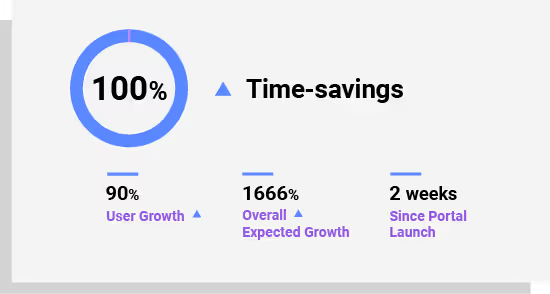React Disaster Response: 100% Time-Savings During a Pandemic
Team Rubicon needed a system that could handle a large influx of new volunteers and that it integrates with Salesforce
RE:ACT Disaster Response (formerly known as Team Rubicon UK) started in April 2015 under the USA branch unofficially but was officially established as its own entity, with its own operations, during the Nepalese earthquake of the same year.
RE:ACT’s mission is two-fold. The first part: respond to quick onset disasters around the world and the UK. The second part: re-purpose military veterans and emergency service responders. Once military personnel are discharged from service, often they lose their sense of purpose - RE:ACT aims to instill a new sense of purpose in them.
Working in conjunction with regional liaisons and partners like the British Red Cross and the UK’s Ministry of Defence, RE:ACT ensures any emergencies that are identified at a local level, that cannot be fixed by the local community, are addressed with a relief effort. Whether it is their own team that helps directly or another organization they partner with, RE:ACT brokers the information to solve the problem at a regional or national level.
Challenges & Discovery
Chris Lyon, head of technology and innovation at RE:ACT, describes the solution that addressed their problems during the global COVID-19 pandemic, “Everything in terms of our efforts in the COVID-19 crisis is very difficult to deal with but the Magentrix team has made it as easy as possible for us. It is much appreciated.”
RE:ACT had been searching for a solution to their challenges for roughly five years. With the COVID-19 plight pushing their systems to its limits and urgently requiring their attention, Lyon knew RE:ACT required a new system now more than ever. A new system that could handle a large influx of new volunteers and that integrated with Salesforce. It was really important to them to implement a solution that would allow flexibility with users, as they have asked 40,000 volunteers to come forward.
Lyon’s first stop was the Salesforce AppExchange where he discovered one of the top-rated apps in its field, Magentrix. Magentrix would allow them to scale up without the growth limitations they previously faced.
Another integral challenge for RE:ACT was that their workflow consisted of four different systems. The operations of all four systems required manual management by humans: one system to engage a volunteer with, a different system to track the response from that engagement, another system to track the needs being discovered and another system to assign the volunteers to those needs.
After speaking with the Magentrix team, RE:ACT soon realized Magentrix was exactly what they needed: “A lot of organizations would have tried to slow the process down, maybe tried to make sure everything was properly done before we went live but Magentrix realized we needed a solution very quickly. Magentrix came out on top mainly because it was going to be rapid to implement but just as importantly, they were giving us a healthy balance of an out-of-the-box functionality and the ability to customize the portal. Their entire team, especially support, was outstanding during our go-live process,” said Lyon. It took RE:ACT 3-4 days to decide on a solution and 5-6 days to go live with the solution.
Results
Although still in its early stages of use, the single biggest difference after implementing a Magentrix customer portal, for RE:ACT, is the self-serve aspect. Volunteers are empowered to manage and update their own information should they need to make a change.
Before Magentrix, volunteers had to call in and ask to have their details changed. The portal eliminates that process and thus, saves a lot of time spent on administrative tasks. In addition, its easy-access nature ensures volunteer status information, such as their availability, is just a few clicks away from being quickly updated - rather than falling off the radar if the volunteer happens to lose touch with RE:ACT. Previously, if volunteer availability numbers weren't updated on a timely basis, this information would become unreliable. Further to this, deciphering the true number of available volunteers would become a hurdle in the face of a new disaster striking, when a response is urgently required from RE:ACT. There was also a lot of liability on the individual's part to keep track of whether a particular volunteer completed a particular task and if they were successful at it - previously this information was not captured, and it was not made available to everyone, at every step of the process.

“As it was very difficult to cope with everything before Magentrix, RE:ACT has now achieved 100% in time-savings - and this number continues to rise. Up until we went live, we had 2,400 short-term volunteers on our books who had just responded to the COVID-19 relief effort and when we went live with the portal, that number jumped to 3,500+ in just a couple of days. Before the portal, we were struggling to engage the 2,400 volunteers. Since we’ve had the portal, we've been able to double our volunteer sign-ups, and engage them all, in just 2 weeks. And it's growing daily - currently by 150-200 people per day. We are no longer struggling to manage that information - because of our Magentrix portal, we can now manage more than we could have ever thought was possible, as it is all now automated. We have eliminated all manual processes,” Lyon said of their experience thus far.

Other hurdles included engagement of volunteers. With the blog functionality of Magentrix, all notices are posted as articles and any volunteer that joins at any time can look at a rich history of operational updates. They can easily review what has been happening to date, and as a result, immediately feel connected to the rest of the RE:ACT community. This has directly led to an increase in volunteer engagement. Volunteers can be engaged a lot quicker now and their interest in helping with disaster relief efforts can now be maintained more than was possible before the use of a Magentrix portal.
Training efforts is another barrier RE:ACT was facing which their Magentrix portal helped with. Among those volunteering are people who have a background as military veterans but no training in the type of operations RE:ACT may face. RE:ACT previously had no efficient solution to providing this training but has now begun to create training modules in Magentrix to tackle this barrier. Training modules will allow RE:ACT to not only instruct the volunteers, but the newfound insight will also enable them to confidently rely on the volunteers, knowing they have a better understanding of what is required from them.
As part of their mission, RE:ACT has lots of different operations around the country everyday. For each of these operations, they had always been sending out various sign-up forms which required several manual steps before they could finally figure out who should deploy each mission. Volunteers can now self sign-up through the portal, rather than an email, “This allows us to concentrate on the areas you can't automate. When the team is spending all their time just dealing with administration and technology issues behind our operations, they're not spending the time actually solving problems and dealing with the real issues.” said Lyon.
RE:ACT used to have multiple systems, not talking to each other, with several manual processes in between. Now, all they do is use Magentrix.
If you have questions about what else customer portals can do and how it may be able to help your organization, we would be happy to tell you.

